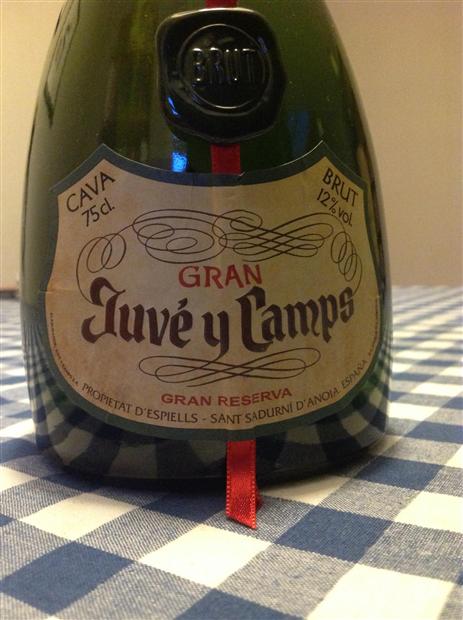
External search
Google (images)
Wine Advocate
Wine Spectator
Burghound
Wine-Searcher
Vintages
2016
2015
2014
2013
2012
2011
2010
2009
2008
2007
2005
2004
2003
2000
1997
N.V.
From this producer
Show all wines
All tasting notes
|
| Drinking Windows and Values |
| Drinking window: Drink between 2014 and 2017 (based on 9 user opinions) |
| Community Tasting History |
| Community Tasting Notes (average 87.8 pts. and median of 87 pts. in 5 notes) - hiding notes with no text | | | Tasted by RolfT on 7/7/2015 & rated 82 points: Nose of apples and hint of sweet liquor.
Creamy mousse. Buttery. Slightly leesy.
Pleasant enough, but not memorable. I paid 35$ for this. I know of better cava (and even some entry level champagne) that are a lot more interesting than this. (1233 views) | | | Tasted by jorivesud on 12/21/2014 & rated 90 points: Pas de note. C'était un cava beaucoup plus complexe que ce que je suis habitué du côté des cava. Les bulles n'étaient pas des plus persista tes, mais le nez et la bouche était vraiement bien. (1504 views) | | | Tasted by Xavier Auerbach on 4/3/2014 & rated 87 points: A private lunch (Restaurant DiverXo ***, Madrid, Spain): Light and refreshing, apples and flowers, juicy, not really distinguished, a nice aperitif. (1932 views) | | | Tasted by Ingarj on 9/12/2013 & rated 87 points: Fruitful with lots of green apples, balanced aromas and an uncomplicated style. (1719 views) |
| By Sarah Jane Evans MW
Decanter, Expert's Choice: Premium Cava (5/5/2017)
(Juvé y Camps, Gran Juvé Gran Reserva, Cava, Catalonia, Spain, White) Subscribe to see review text. | By Ferran Centelles
JancisRobinson.com (4/24/2014)
(Juvé y Camps, Gran Reserva Brut Cava White) Subscribe to see review text. | By Sarah Jane Evans MW
Decanter
(Juvé y Camps, Gran Reserva, Gran Juvé, Cava, Spain, White) Subscribe to see review text. |
NOTE: Scores and reviews are the property of Decanter and JancisRobinson.com. (manage subscription channels) |
| Juvé y Camps Producer website
Juvé y Camps is a family-owned winery located in San Sadurní d’Anoia, a small town in the northeastern Penedès region near Barcelona. Founded in 1921 by Joan Juvé Baqués and his wife Teresa Camps Farré, the winery’s three-generation history has resulted in an international reputation for producing top-quality Cava.
From the beginning, the winery’s philosophy has been to use only traditional, high-quality winemaking practices. Its Cava is made in the método tradicional, as is Champagne, meaning it undergoes a secondary, in-bottle fermentation prompted by the addition of yeast and sugar. The wines are often aged in bottle for 18 months or more.
Juvé y Camps comprises 2700 acres of vineyards. Those acres are divided into three properties where native varieties Parellada, Macabeo and Xarel-lo are grown.
Spain Vinos de España - Wines of Spain (Instituto Español de Comercio Exterior) | Wikipedia
Wine Map on weinlagen-info
Spain is the third largest wine producing nation in the world, occupying the majority of the Iberian Peninsula with vast diversity in climate, culture, and of course, wine. From inky, dark reds of the [Priorat] to dry, white Finos from Andalusia, Spain can easily boast of elaborating a wide variety of notable styles. Within Spain there are currently 62 demarcated wine regions, of which a handful have gained international recognition: [Rioja], Priorat and [Ribera del Duero]. Yet these regions are only a small sample of the high quality wines Spain produces. Regions such as Cava, Penedes, Somontano, Galicia, Rueda and Jerez are only a few of the numerous regions worthy of exploration throughout Spain. Spain can also lay claim to having the most land under vine in the world, growing up to, by some accounts, 600 indigenous varietals of which Tempranillo is their most well known. Other popular varietals include [Garnacha], Bobal and Monastrell for reds and for whites; the infamous [sic] Palomino Fino grape which is used in the production of sherry wine, Pedro Ximenez in Montilla Morilles, Albarino used in the creation of the bright, effervescent wines of Galicia, and Verdejo in Rueda. - Source: - Catavino.net
Spain is not in the forefront of winemaking for its dessert wines, other than for its sweet wines from Sherry country including the highly revered Olorosos (when sweetened). But apart from Sherry Spain has a range of styles of dessert wines, ranging from the those made from the Pedro Ximenez grape primarily in Jerez and Montilla-Moriles) to luscious, red dessert wines made in the Mediterranean from the Garnacha (Grenache) grape. Some good Moscatels are made in Mallorca, Alicante and Navarre. The northwest corner of Spain, Galicia, with its bitter Atlantic climate, is even making dessert wines, called “Tostadillos” in the village of Ribadivia (similar to France’s “Vin de Paille”). The Canary Islands have made interesting dessert wines for centuries (they are mentioned by Shakespeare, for example) and in recent years the quality of winemaking has been improved and the Canary Islands wines are being better marketed now. The winemaking styles for “Vinos Dulces” are also diverse, from “Late Harvest” (Vendimia Tardía) to “Fortified Wines” (Fermentación Parcial). Based on in-spain.info.SpainRioja
Clearly stated from Rioja as all Faustino I GRCava D.O. Cava
Cava was born under the constant shadow of its French counterpart, Champagne. However, produced over 1,200km away and a gap of over 100 years, Cava was always going to be a completely different product, even if produced using the same method and and sometimes with the same varieties.
Firstly the climate and soil have a profound impact on the yields, while the plant strains that thrive here and completely different to those in the Champagne region.
Fortunately, as more winemakers are becoming convinced of this, they are producing Cavas with their own personality, showing off the art of the second fermentation in the bottle like no other wine region in the world. |
|




